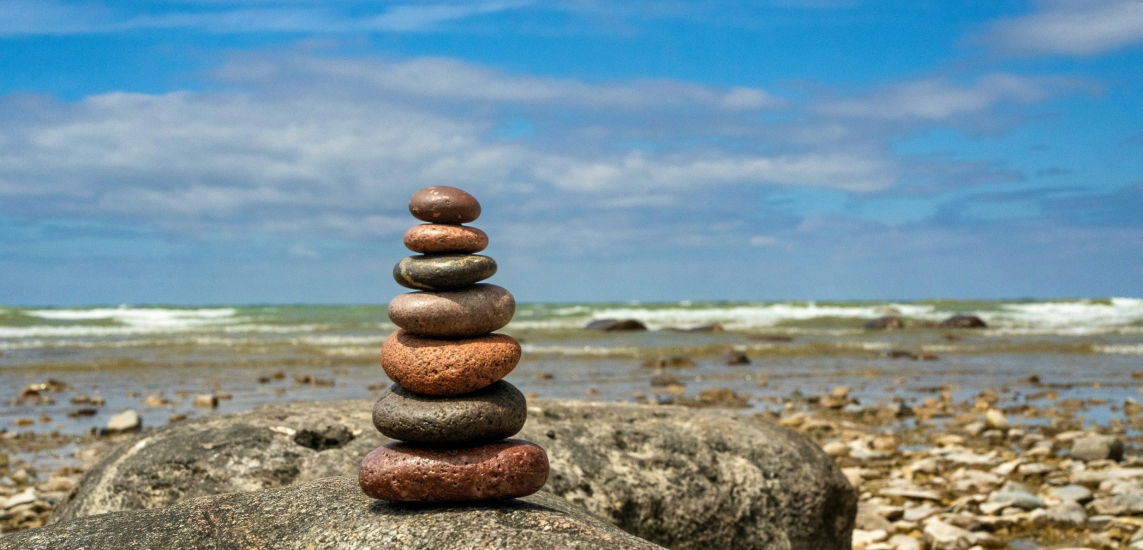This is a slightly simplified transcription of Tara Brach’s talk on facing pandemic fears, given on March 18th, 2020, during the collective coronavirus crisis.
Pandemic Fears & Collective Suffering
I don’t need to name it really: These are frightening times. And I imagine, like myself, most everyone reading has some real fear maybe for yourself or for others that are close in or maybe it’s the fear for so many in our world that are struggling.
What is going on now feels quite different than personal suffering. What I mean by that is in contrast to if we get that cancer diagnosis or a relationship fails. We are all in it. There is that well-known saying “Be kind. Everyone you meet is fighting a hard battle.” And what’s growing clearer than ever is that each of us is having to face – at a different pace but face – our vulnerability and it feels out of control and it can feel scary.
For me, my daughter-in-law is pregnant and she is a nurse working at the largest hospital in the San Francisco area committed to staying on, so she is super high risk. And my son’s father, who is a very dear friend, lives with them because he is very ill, he has a severe heart-condition, so he might not survive the virus and it’s very likely it’ll be brought into that home. It’s complex. But that’s scary.
And then, of course, I have many more friends in quarantine as probably so many of you and many, many friends who are financially on the edge. And we know: Pandemics are toughest on those who are most vulnerable, it’s been like this through history, so those with the least access to good jobs, reliable incomes and the resources of our society, they are the ones that are most likely to contract the virus, to die of it and, if they don’t die, to be financially devastated.
As I imagine this—the close ones that I know and those that I don’t know, how our hospitals are quickly running out of supplies, how there will not be enough beds and ventilators—what comes up in me is this very real mix of fear, I feel grief, my heart’s anticipating real loss, there is a rawness, a tenderness, and with all that is also a sense of possibility, the possibility that this suffering that’s so deep and so wide will wake up our hearts in a collective way.
Explore Insight Timer’s coronavirus resources including articles, guided meditations and courses that can help you cope with anxiety and panic, feel connected to other people, cultivate compassion, shift into a positive mindset and establish a healthy routine in times of social isolation.
Who Do I Want To Be Through This?
Many of you are familiar with the Bodhisattva aspiration. A Bodhisattva is an awakening being. The words are: May whatever arises, whatever circumstances arise, may they serve the awakening of compassion. So, I want to bring that into our shared reflection because this prayer is really very deep in me; that: May this suffering awake in this heart and all hearts, may it help make love go viral. That’s really the prayer.
Maybe I’ll pause for a moment and just invite you to sense in (listen to the audio for this practice):
- Sensing In - Short Practice Tara Brach
These are important questions, my friends. They’re important, because our prayer, our sensing “Who do I really want to be through this?” has a power to guide us. Many of you love and know this teaching from Zen master Thich Nhat Hanh. He writes that when the crowded Vietnamese refugee boats met with storms or pirates, if everyone panicked, all would be lost, but if even one person on the boat remained calm and centered, it was enough, it showed the way for everyone to survive. And here we are. We are in the midst of this huge unprecedented uncertainty, reactivity, fear and confusion and a lot more. Can we be that person? Because, in a way, we have been training for this. Each of us in our own ways, we’ve been training how to open more in our personal life to the joys and the sorrows, to the fears, to the losses with an awake heart. We have been training. So, if you’re intentional right at this juncture in time, if you’re intentional how you want to move through this, the suffering that arises can turn you towards your deepest resources, we kind of get begged into it, into our bravery and into our wisdom and our love. I’m sure you’ve seen it in your own life; how it’s often the periods of suffering—the real losses, the failures—when we actually grow, when our consciousness wakes up some.
We’ll look together now at how these very circumstances of our times—the dangers that are presented to our bodies, our health, our life, our loved ones, our financial security—how these very circumstances can be grounds for compassion. I’d like to do this in two parts; first how what’s going on and what’s coming up in us can create an inner refuge of love and of presence, how can we do that, and the second part is how we can find refuge with each other because if ever there was a time for sangha, if ever this world is going to experience truly moving through something holding hands—whether it’s virtually but our hearts together—this is the time.
Explore all of Tara Brach’s talks and guided meditations in her free library on Insight Timer.
Part 1: The Pathway To Inner Refuge
I’d like to name that it’s important that as we practice with the fears that come up, as we seek inner refuge, that we remember that fear is utterly natural and appropriate when we are facing danger and loss. I love the language “It’s nature’s protector,” it’s telling us to take good care. I’d say in the United States we haven’t been awake and scared enough to do what we needed to do to prevent as much loss as may be coming. Fear is an intelligent part of us. But so often when it comes up, there is a sense of “Oh, I shouldn’t be experiencing this,” “There is something wrong with me for feeling fear” and a sense that we should just try to get rid of it.
One of the most powerful little practices I do when fear comes up is I’ll mentally whisper “This belongs,”—it’s like “It’s a wave in the ocean and it belongs.” So fear is natural, it’s intelligent, and the challenge is that if we don’t know how to be mindful of fear, if fear possesses us, then it can become truly debilitating. When we get hijacked by fear, we lose contact with our most recently evolved part of our brain, our frontal cortex, we lose contact with compassion, we lose contact with perspective, with humor, with all executive functioning. It’s a matter of degree, of course, but fear, when it takes over, causes a tremendous amount of suffering. And in a pandemic it’s contagious and can become widespread. It becomes one of the greatest dangers of a pandemic. So again that question: Can we be that person in the boat who feels the intelligence of the fear but knows how to hold it with mindfulness and with compassion?
Bringing The Practice Of RAIN To Fear
This is where the training in mindfulness comes in and we’re going to explore it by bringing RAIN—which is a weave of mindfulness and compassion—to fear. How do we find that inner refuge of calm in the midst of the storm for ourselves and for the sake of others?
Returning Inside The Window Of Tolerance
I’d like to start by saying: When fear is really strong, when it’s the level of panic, when it’s trauma, we’re, what’s called, outside the window of tolerance and that’s a phrase from my friend and colleague Dr. Dan Siegel, a great psychiatrist. He describes the window of tolerance; if we are within it, if fear’s within it, then we can bring mindfulness and compassion and really trust in our relationship to it; but when it gets outside the window of tolerance, we first need to calm down our nervous system, we need to do some reducing of the activation of the sympathetic nervous system, of fight-flight-freeze.
There are a number of ways we can do this. And you are probably familiar with them. They are all forms of nurturing ourselves, helping us to feel some sense of safety and love. And one of them that is so helpful is breathing—a long deep breath, counting to five on the in-breath and then counting to five on the out-breath. If you can do that for a few minutes—ten minutes, fifteen minutes—you totally shift your nervous system around.
Other ways of calming fight-flight-freeze: Grounding—and that means feeling gravity, feeling your belonging to the earth. Part of grounding might be to touch the fabric of what you are wearing and just sense the surface of the desk or the material of your chair, name something you are seeing in the room, so that you are bringing yourself into the here and now with your senses. Another way of reducing fight-flight-freeze is by offering comforting phrases to yourself or by imagining a person or place that feels safe to you, a person that’s loving. And then there are the physical ways of shaking, of stretching, of free movement, dancing, walking in nature. Each of these has a common denominator in a sense: that they actually quiet thoughts. And that’s important because, as you know, fear-thinking, the thoughts in our mind can then affect our biochemistry and then we get trapped in a cycle that keeps us a prisoner of fear.
The most basic practice for quieting thoughts is to train in being mindful of thinking, so that as you are meditating you are just getting the knack of noticing when a thought is there so you can actually say “Oh this is a thought” and have a choice to come back to the breath or the body or the sounds. One of the most intuitive and true and useful kinds of quotes that is attributed to the Buddha is that whatever you regularly think about becomes the inclination of your mind. When there is real danger around us, we actually go in hyper-drive with worry. So it’s intelligent to be aware of danger and it actually causes suffering and makes us less effective in responding when we perseverate. It’s always been interesting to me that the word “worry” has the roots in the English language of “to strangle.” The intention in practicing mindfulness is to be mindful of fear-thinking and come back into our senses. If we can come back into our body or to breath or to our senses we can then have a choice as to deepen our presence and we can really begin to heal the roots of the fear.
Buddha And Mara
Once we have done that, once we have dealt with super-intense fears, we have grounded, we’ve shaked, whatever we do to calm the nervous system, that’s when we can start deepening attention with RAIN. For those of you that aren’t familiar: RAIN is a weaving of mindfulness and compassion and the letters of the acronym give us an easy-to-remember sequence that can help us to Recognize what’s going on, R. A, Allow it to be there. I, Investigate it, and N, Nurture it. And then there is After The Rain where we actually rest in presence. This weave of mindfulness and compassion in a kind of evolutionary sense shifts us from fight-flight-freeze to attend and befriend.
I’m thinking right now of my favorite story that in a sense is most psychologically sophisticated in some of the Buddhist lore, of the Buddha teaching. He’d be teaching in these, you know, fields and there’d be many people there. And often when he’d be teaching the God of the shadow-side whose name is Mara—that’s the God of fear, of hatred, of anger, of lust, of confusion, of uncertainty—would always show up and kind of lurk around the sidelines. The Buddha’s loyal attendant, who is also his cousin, Ananda, would see Mara and be pretty freaked out; “Oh my God, fear, fear is here!” And he would go to the Buddha and say, “What are we going to do?”, and the Buddha would calm him down and say, “It’s fine.” And then he’d walk over to Mara and say, “I see you, Mara. Come, let’s have tea.”
This is a model of how we can come into a relationship with fear in a way that frees us. You can see it in RAIN how it works when we start with the Recognizing, that’s “I see you Mara”, “Let’s have tea,” is Allowing, we’re not going to fight, it’s okay. It’s kind of the beginning of warmth. And then the Investigate is “I really see you, Mara,” looking deeper into Mara, really understanding Mara. And Nurturing is when having tea becomes a sense of communion, of love.
Step 1: The Power Of Naming What Is
Because we are particularly applying RAIN to fear in this exploration, some of the keys are that recognizing means whatever is predominant in our lives. And it’s a very powerful way, if you can, when you recognize it, just with a mental whisper name what you are aware of—“Okay, fear, anxiety, worry, agitation.” There is really good research from UCLA that describes how when you name an emotion it reduces the limbic activity, the unpleasant emotions, and it activates the prefrontal cortex, which gives you much more resourcefulness. So, naming an emotion just right at the very get go—“Okay fear is here”—there is a little more space, there is a little more awareness, you’ve reconnected to your resourcefulness. The Shaman have an understanding that when you name a fear it loses its power. Of course not all at once. But this is the beginning of RAIN, Recognize, the power of naming.
Step 2: Allowing Fear To Be There
The second step, Allowing. Now, what happens when we try to allow fear? It’s not easy because most of us want it to go away. You’ll notice with allowing comes a bargaining mind, “Okay, I’ll allow you to be here if you go away.” The problem is: it knows. You can’t really get away with a bargaining mind. But it’s a natural, it’s natural that there’s a part of you that wants the fear to go away. Allowing doesn’t mean you have to wholeheartedly toss aside all resistances and just open your being because you can’t legislate that. It just means there is some level of willingness to let it be there, to let be some level of willingness. And that you can offer because there is some wisdom in each of us that knows that what we resist persists, that if we fight it, we’re going to be imprisoned by it. I often will just say “Okay this belongs” as I mentioned earlier. That creates some space of allowing.
Step 3: Feel The Fear In Your Body
So, we’ve just done Recognize, “I see you Mara”, and Allow, “Okay we’re going to get together, I’m just going to be with you for a while,” it’s like “I’m willing to pause with you.” With fear we typically need to go deeper which is why we need the Investigate and the Nurture.
Investigating… we’re really asking ourselves “What am I unwilling to feel about this?” And investigating is somatic. The biggest misunderstanding of RAIN is that investigating is cognitive. There can be some cognitive questions but they need to bring you back into your body because, as we know, our issues are in our tissues so it’s not until we bring a full presence to the fear in our body that we actually find freedom from it. Investigating might have a question like “What most wants my attention?” “Where am I feeling this?” “What does it feel like?” With investigating it’s very helpful to bring your hand to wherever you feel the fear. And it’s usually the throat, the chest, the belly. There are two reasons: One is that when you bring your hand there, it’ll help you keep your investigating attention where you’re looking because our mind tends to scatter, so it helps to focus the investigation. But it also begins to offer some Nurturing. Because if investigating isn’t gentle or kind, then we won’t be able to really discover anything. You might think of the parts of us that are fearful as these shy creatures that hide in the shadows of the woods and we’re trying to bring them into the light of awareness by investigating. And that means it needs to be an invitation, you know, we need to invite the vulnerability to show itself, the hand can be helpful with that.
Step 4: Find What’s Nurturing You
Then comes the nurturing. We investigate and find out what this vulnerable part really needs. This nurturing we really have to customize. Each one of you needs to find for yourself what really feels nurturing in this moment. And with fear, as with any other emotion, sometimes it’ll be words of comfort, sometimes it’ll be words like “I am here, I am not leaving,” “I care about you,” “You are not alone,” “I am sorry and I love you,” “It’s okay sweetheart,” there are different words you might find. Often it’s the continued touch and to keep it tender. And sometimes as we’ll practice, we let the nurturing come from a larger source. Nurturing doesn’t mean it’s self-nurturing. Nurturing means that we’re nurturing the vulnerability calling on whatever source of love, our own awake heart or something that we perceive as larger to offer kindness.
What Comes After RAIN?
Let me give you a little example that is quite current with myself. This was just a few days ago. Because, as I shared with you, my nervous system is agitated I’ve woken up in the middle of many nights now sensing those that are close to me that are vulnerable and also just the countless numbers of vulnerable people, it feels like a lot of impending loss. So, often I’ll do my meditation down by the river when I’m walking. I walk and then I do a meditation sitting on a rock by the river. I was feeling the agitation in my body. I recognized it “Okay, agitated, afraid.” And then A was Allow just “Okay,” agreeing to let it be there. I didn’t like the feeling, so I allowed myself to feel that I didn’t like the feeling. I began to investigate asking myself, “What’s this like?” I could feel it was in the chest area and sensed it was kind of squeezing, there was kind of crushing feeling. (It helps sometimes, with investigating, to just name what you are noticing there, you note as a mental whisper—feeling into what is most vulnerable.) The investigating was, “What really am I unwilling to feel?” or “What really wants attention?” I went right into the epicenter of where there was the most of a twist and a squeeze and the unpleasantness of fear. And I just started breathing with it. And the intention was a kind of surrendering presence, “Can I just feel this, just feel this exactly as it is?” And as I did I just started sensing into, “What does this squeeze of fear most need?” And it was clear that what it most needed was pure loving. It most needed to belong, to love. It was like the waves needed to belong to the ocean. The nurturing then was really calling on the entire universe, it wasn’t an abstract universe, a very intimate, a vast field of loving, just imagine and feel it washing into vulnerability, washing in, washing in, and there was just a background of a whisper of the word “beloved, beloved” washing in, washing in. And with that there was a dissolving. There was still a tenderness, it was full and big. And that led to After The RAIN.
The moments that you’ve gone through Recognize, Allow, Investigate and Nurture, what we call After The RAIN, if you skip it, you miss the deep transformation and realization that’s possible in the process because it’s during After The RAIN—when we rest in the presence that’s there—that you start becoming familiar with that presence as more true, more the truth of who you are than any of the stories that you were living in. So, rather than being the agitated self or the scared self, that open, tender awareness was what I felt as the experience of my own being. And it could include whatever was coming and going. RAIN is a tool of radical compassion. It has certain key elements that—if you can, with the recognizing and allowing and investigating, really get embodied, really feel directly the fear without resistance and then if you can actively nurture, like really sense actively the care and the love, you’ll discover that kind of all-inclusive presence that we call radical compassion.
Loving The Fear
The secret, the key piece really for me, is loving the fear. And here is the deal: If I started off when I felt fear saying “Okay I’m going to love this fear,” it would just be my ego trying to will myself to love fear and that wouldn’t be possible ‘cause the biochemistry of fear and the biochemistry of love are so different. But we can gradually unfold into loving the fear by first just recognizing it, allowing it as much as possible, and then that gentle investigating in the body, putting our hand there until gradually there is a sense of vulnerability, being in relationship with it in a way that love can wash through us.
RAIN is never a one shot. For anything that’s a deep and ongoing emotional experience we have to keep doing it. But here is the good news: every time you practice with fear, the pathway of finding inner refuge becomes more spontaneous and more natural, you find your way more easily. Sometimes it’ll take a longer time than what I described and sometimes much quicker. In fact, one teacher from our meditation teacher training program was sharing how they’ve been using RAIN to deal with what she called “a pandemic trance”, of just getting caught in the agitation—the fear, all the reactivity—and she described how even a light RAIN could help her when she felt this fear for what was around the corner, she would recognize it and allow it and then she’d find in her body and just take three breaths, breathing with it, just three breaths and tell herself to come to your heart and be quiet for some moments and feel the quality of the presence that was there, that was it, just a few minutes.
I invite you to explore it in light ways and deeper ways. And it really can free you up. We’ll just practice a little bit right now just to give you a taste especially if you are new to RAIN on how to bring RAIN to fear:
- RAIN Practice Tara Brach
Part 2: Deepening Our Heart Connection
We spent a good amount of our time talking about the pathway to inner refuge, how to bring RAIN to the fear within us and really wake up a compassionate heart. The second part is that, if we have been able to befriend the fear that’s within us, that heart-space naturally can include others, so that, in this time of pandemic while there is physical distancing, we can deepen our heart connection.
Last week, I did an interview with the Washington Post. And one of the questions that the reporter asked me was, “Well, so how is this for you?” And I shared what I’ve shared with you, that I do have these very real fears for close in beings and really real fears for countless beings I don’t know. And then she asked me, “So what does help?” And I talked about this meditation practice and RAIN and I also talked about walking in nature— if I had to say what my real religion is, it’s probably taking refuge in nature, the wild flowers by the river as spring is here, it’s wonderful. And then I said, “You know, in the deepest way it’s the moments of being real and open-hearted with others.” And there is a quote—it used to be attributed to the Buddha and I’m not sure now but it’s a great quote—which is that our fear is great but greater yet is the truth of our connectedness. That’s the opportunity right now. And yet we need to be conscious about it because—and this is in contrast to other natural disasters, like volcanoes and earthquakes and so on—pandemics can actually be a setup for disconnection because our fear of each other can separate us. There is the physical distancing, there is competition for scanned resources… It can actually exacerbate loneliness and depression and feelings of distance. And, interestingly, it really can shut down compassion.
Historically, in pandemics people have often been so terrified, so filled with dread of each other they weren’t able to take good care of each other. Of course, the exception has been through the ages, the heroism of healthcare workers. But for most there has been dread. So, it’s important to know that and also know that we have ways to face this conditioning, to be aware of that tendency to feel separate and then to bring our deepest intention to actually leaning in with our hearts.
The 3 Domains Of Reducing Fear & Increasing Love
There are three domains where we can, with each other, reduce the fear and increase the love:
One of them, quite simply, is to get in the practice of reaching out to each other, being with each other by phone. There is a growing number of online sitting groups, times where we actually can just share with each other “This is what it’s like for me. And when I practice with this this is what’s happening.” What we are afraid of, what our aspiration is. For those of you that are familiar with RAIN it’s a really powerful time in our lives to have a RAIN partner. So reach out. Team up. Be open. Be vulnerable. Be real with each other is so rewarding. That’s the first one.
The second is: Engage in ways that can be helpful. When we are traumatized, the feeling is of powerlessness, we are in a deep feeling of being threatened but we freeze. And one of the healing processes in trauma is to engage in a way that can bring us towards healing and safety. Part of that is engaging with and helping each other. We can reach out to someone who might be lonely. It makes such a difference. Whether for you the other ways of engaging might be dedicating time or money to initiatives that are helping others, directly volunteering… Two friends this weekend were on the bike trail and they made their intention they were going to have eye contact, smile and wave at as many people as possible to kind of send out that sense that we are here together. They came back and reported such a high from that, just the feeling of connection. What went viral in Ireland, some of you may have heard through Tweeting, was the message of who needed medicine and food for the elderly and it got matched with volunteers. You can support people on the front lines, the healthcare workers, by walking their dogs or getting food or taking care of their children. So the first way: Reach out and be with your friends and your peers. The second way: Engage and help.
The third way—and it’s critical that we don’t forget this: celebrate the goodness that’s here. Walk outside, take in the beauty of spring, take in the dearness of those that you might be working at home with or the caring of so many in this world who want to serve the good.
Read more: Discover Jane Murray’s article about managing fears in uncertain times with your own goodness.
Physical Distance Does Not Limit Our Hearts
You know, a few days ago in the New York Times there was an article on Italy, it was so poignant. It said “It started with the national anthem, then came the piano cords, trumpet blasts, violin serenades and even the clinging of pots and pans all of it spilling from people’s homes out of the windows and from the balconies rippling across the rooftops. Finally, on Saturday afternoon, a nationwide round of applause broke out for the doctors on the medical front lines fighting the spread of Europe’s worst coronavirus outbreak.”
In China, patriotic truck drivers risked infection to bring desperately needed food to the people of Wuhan, to the epicenter.
In Iran, there are videos that show doctors in full scrubs and masks dancing to keep people’s spirits up.
And of course here in the States we had Stephen Colbert, the comedian, he did his last live audience and he was saying, “You know, at times like this we all need to laugh, we all need to be together.” And then he kind of backed away and he said, “from a distance of about twenty feet.”
Fortunately, physical distance does not have to limit our hearts.
In closing, my friends, when things fall apart as they are collectively, we can turn to that beautiful aspiration “Please may this serve the awakening of our hearts.” For you to really ask yourself: What is being called forth in you? Who do you want to be through this? How do you want to be? And really together, what kind of world do we want? What can we build out of this? Just so aware of the viral contagion and the panic is contagious and loving presence is contagious. We have this opportunity to make this a viral time of caring.
Let me close with a poem and we’ll just be quiet together and do a brief closing meditation:
- Concluding Practice Tara Brach







